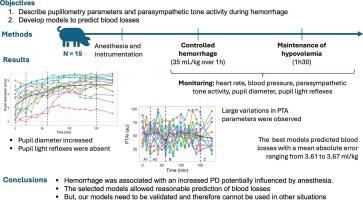Indirect assessment of autonomic nervous system balance for prediction of hemorrhage: A preclinical study in a porcine model
IF 1.8
3区 农林科学
Q1 VETERINARY SCIENCES
引用次数: 0
Abstract
Hemorrhage is a common and significant complication of trauma or surgical procedures. Rapid and accurate assessment of a patient's condition during hemorrhage is crucial for management. The primary objective was to describe pupillometry parameters and parasympathetic tone activity (PTA) during hemorrhage. The secondary objective was to develop a model to predict blood losses.
In this preclinical study, 15 pigs were used. After anesthesia, 35 mL/kg of blood was removed over 1 h. Hypovolemia was maintained for 90 min. Indirect assessment of autonomic nervous system balance was based on the monitoring of heart rate (HR), blood pressure (BP), shock index (SI), PTA and pupil diameter (PD). PD and the pupillary light reflex (PLR) were measured using a portable pupillometer.
HR and SI significantly increased during hemorrhage, whereas BP decreased. PD increased significantly during hemorrhage (+0.03 mm/min, [0.01; 0.04]; then +0.01 mm/min, [0.01; 0.02]) and the hypovolemia period (+0.004 mm/min, [0.002; 0.005]). PLRs were absent in 251/254 measurements. Large variations in PTA parameters were observed over time, which prevented statistical analysis. The best models predicted blood losses with a mean absolute error ranging from 3.61 to 3.67 mL/kg.
In conclusion, hemorrhage was associated with an increased PD potentially influenced by anesthesia. The selected models allowed reasonable prediction of blood losses with a slight tendency to overestimate. The study provides proof of concept for the use of this kind of models to predict blood losses. The results must be confirmed in other contexts: with different species, other anesthetic protocols, or different surgical procedures.

自主神经系统平衡预测出血的间接评估:猪模型的临床前研究。
出血是创伤或外科手术常见且重要的并发症。快速准确地评估出血期间患者的病情对治疗至关重要。主要目的是描述出血期间瞳孔测量参数和副交感神经张力活动(PTA)。第二个目标是建立一个预测失血的模型。在这项临床前研究中,使用了15头猪。麻醉后1小时内取血35ml /kg,低血容量维持90分钟。自主神经系统平衡的间接评价基于心率(HR)、血压(BP)、休克指数(SI)、PTA和瞳孔直径(PD)的监测。用便携式瞳孔计测定PD和瞳孔光反射(PLR)。出血时HR和SI显著升高,而血压降低。PD在出血期(+0.03 mm/min,[0.01; 0.04],然后是+0.01 mm/min,[0.01; 0.02])和低血容量期(+0.004 mm/min,[0.002; 0.005])显著升高。251/254次测量中没有plr。随着时间的推移,观察到PTA参数的大变化,这妨碍了统计分析。最佳模型预测失血量的平均绝对误差在3.61至3.67 mL/kg之间。总之,出血与PD增加有关,可能受麻醉的影响。所选择的模型可以合理地预测出血量,但有轻微的高估倾向。该研究为使用这种模型来预测失血提供了概念证明。结果必须在其他情况下得到证实:不同的物种,其他麻醉方案,或不同的手术程序。
本文章由计算机程序翻译,如有差异,请以英文原文为准。
求助全文
约1分钟内获得全文
求助全文
来源期刊

Research in veterinary science
农林科学-兽医学
CiteScore
4.40
自引率
4.20%
发文量
312
审稿时长
75 days
期刊介绍:
Research in Veterinary Science is an International multi-disciplinary journal publishing original articles, reviews and short communications of a high scientific and ethical standard in all aspects of veterinary and biomedical research.
The primary aim of the journal is to inform veterinary and biomedical scientists of significant advances in veterinary and related research through prompt publication and dissemination. Secondly, the journal aims to provide a general multi-disciplinary forum for discussion and debate of news and issues concerning veterinary science. Thirdly, to promote the dissemination of knowledge to a broader range of professions, globally.
High quality papers on all species of animals are considered, particularly those considered to be of high scientific importance and originality, and with interdisciplinary interest. The journal encourages papers providing results that have clear implications for understanding disease pathogenesis and for the development of control measures or treatments, as well as those dealing with a comparative biomedical approach, which represents a substantial improvement to animal and human health.
Studies without a robust scientific hypothesis or that are preliminary, or of weak originality, as well as negative results, are not appropriate for the journal. Furthermore, observational approaches, case studies or field reports lacking an advancement in general knowledge do not fall within the scope of the journal.
 求助内容:
求助内容: 应助结果提醒方式:
应助结果提醒方式:


